Question about Valsalva and protecting the spine during the drive.
January 23, 2017
Questions from a rowing coach.
Good evening Coach Kaehler,
I would like to ask you as question and would appreciate your feedback. Question is related to your specialty and is about Valsalva movement in rowing and it’s impact on the spine. From my current reading I see that Valsalva movement in Rowing particularly protects spine form putting high loads on the drive, but would like learn more about it. Looking forward to hearing your feedback. Thank you. Rowing coach in US
Coach Kaehler’s Response
Valsalva stiffens the spine when humans lift heavy objects and is one of several mechanisms that help stiffen the spine. Non-traumatic injuries occur in all sports at change of direction, especially as speed increases. In rowing the body is moving the fastest at the finish of the stroke where the largest momentum shift happens at change of direction, catch is the slowest point of the stroke and change of direction (least momentum change) is smaller. So if you are going to implement this strategy you would need to hold your breath at the finish to minimize greatest horizontal shear during the entire rowing stroke.
ANSWER BACK:
Valsalva is a natural automatic spine stabilizing mechanism that rowers use at the catch to try and improve spine stiffness. In my experience stabilizing a poorly positioned spine with valsalva will not reduce the low back injuries. I have helped hundreds of rowers to completely eliminate chronic low back pain, in one training session, and I can tell you that low back injuries manifest because other muscle systems are weak and/or inflexible. These imbalances create poor spinal posture that places excessive stress (horizontal shearing) on the passive tissue at the finish of the stroke.
Athlete Profile: Lindsay Jennerich
September 7, 2011
Canadian Lightweight rower on training with Mike Spracklen,
breaking stereotypes, and pulling together when it matters the most
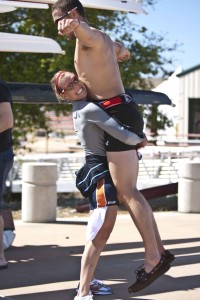
Canadian lightweight Lindsay Jennerich hoists heavyweight Rob Gibson (Photo Kevin Light)
By Yasemin Watkins for Coach Kaehler
Need a little inspiration? Feel like you’re fighting the odds?
Read on, because according to Canadian lightweight rower, 2010 world champion and 2011 world silver medalist, Lindsay Jennerich, it’s all about one thing, “Belief in what you’re doing. Knowing you’ve done everything you can to win.”
Sounds simple enough, but Jennerich – her philosophy and approach to training — make her both perplexing and intriguing at the same time.
To many, she’s a head-scratcher.
Just when you think you’ve checked all the competition, read all the results, facts and figures. Just when you’ve spoken to all the people “in-the-know,” stacked and weighed all the conditions. Just when you think you’ve got it all figured out, she comes out and pulls a fast one.
In this case, a really fast one.
A final and powerful sprint secured her boat for the 2012 London Olympics, and propelled her and her partner to a silver medal finish at the 2011 World Rowing Championships.
That’s Lindsay Jennerich I’m talking about.
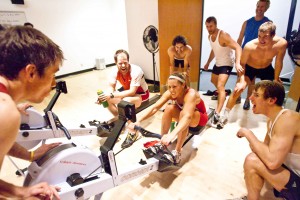
Three Stroke Max: Breaking 500 watts with a little help from some friends. (Photo Kevin Light) Front of erg - Malcolm Howard, Back Row - Cam Sylvester, Fraser Berkhout, Gabe Bergen, Doug Csima, James Dunaway (sitting) and Steven Van Knotsenberg
The 5’5” Canadian power-house, together with her super-subbing partner, Patricia Obee, took second place in the women’s lightweight doubles (LW2X) event at the 2011 World Rowing Championships in Bled, Slovenia. Although Jennerich was the reigning world champion (with partner Tracy Cameron), this outcome was not what the experts had predicted.
With 2012 Olympic boat qualifications on the line, the recently-held Championships were the most important event of the 2011 racing schedule. Athletes hope and pray that their endless hours of erging, rowing, conditioning and sacrifice set them up for peak performance at this most crucial event, when competition is at its pre-Olympic best.
At the lead-up world cup event in Lucerne, Switzerland, Jennerich and Cameron won the LW2X and looked poised to successfully defend their world championship title only weeks away.
A rib injury, however, sidelined Cameron from the LW2X and temporarily altered the script.
To help Jennerich qualify the LW2X boat for the 2012 Olympics, and then defend her world title, Rowing Canada shifted the boating assignments. They placed Cameron in the LW1X (a non-Olympic event) where she placed a respectable 6th, and paired Patricia Obee with Jennerich for the more important LW2X event.
Cameron’s substitute, Obee, is an equally logic-defying 5’4” lightweight rower. At the tender age of 19, she’s already seen her share of international success (3rd in the LW1X at the 2011 U23 World Championships; 8th in the LW1X at the 2011 Lucerne World Cup; 3rd in the W8+ at the 2010 U23 World Championships). Obee trains with Jennerich in Victoria, B.C.
Qualifying for Olympic events is no easy task, even for reigning world champions. And having only 4 weeks to ‘gel’ with a new partner, didn’t weigh the odds in the Canadians’ favor.
Jennerich’s response to the monumental pressure?
“Just another race as the underdog,” she tweeted at the onset of Bled racing. “I love it!”
Not the reaction of your average athlete. But then, Jennerich is not average. Not even close.
To understand Jennerich’s “amped” psyche, you have to understand a little about her background and less-than-conventional approach to training.
First, she’s smaller than most world-class rowers. Openweight women average about 6’ tall; lightweights about 5’8”. Jennerich’s stands 5’5”, more in line with “coxswains” – or smaller crew-members who sit in the stern and guide the boat. Frustrated at being “constantly overlooked” by her college coaches because of her size, Jennerich shed a few pounds and started rowing as a lightweight. A definite step in the right direction.
Second, for most of the year, Jennerich trains thousands of miles away from her sculling partner, Cameron, who is based in London, Ontario. Jennerich explains that in London, “the water freezes over and there is too much time on the erg.” In the winter, she prefers instead to split her time training on the water and indoors on the erg.
“Tracy supports my decision to train in B.C.” says Jennerich. “She feels as strongly about training in London as I feel about Victoria.”
“It’s all about belief in what you’re doing,” says Jennerich. “Feeling like you’ve done everything you can to win.”
From Cameron’s point of view, she agrees that training apart in the winter months and early in the Olympic cycle is “not necessarily a bad thing.”
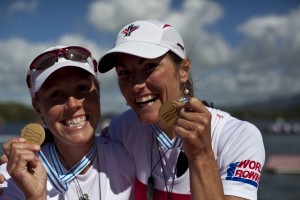
2010 LW2X world champions Lindsay Jennerich and Tracy Cameron (Photo Kevin Light)
“Lindsay and I are both mature athletes who know how to maximize our training regardless of the environment that we’re in,” says Cameron. “In Victoria, she has a great support system – her family, her boyfriend, and a great training group. These things alone can help improve performance. “
“When we come together, it can take a few weeks to gel or blend our individual styles to sync into the double,” adds Cameron. “But once we’ve had that initial time together, we really start to connect. We both understand where boat speed can be found, and we have the same understanding of how to find that speed together. I think that’s why we can sync into each other’s rhythm so quickly.”
Bottom line: they’re both committed to the same goal.
“The Olympic gold medal is what we’re after,” says Cameron. “We’ll do whatever it takes to improve our performance over the next 11 months.”
This brings us to the third point. For Jennerich, “whatever it takes” means training with the men instead of the women — the heavyweight men to be exact, along with their legendary coach Mike Spracklen. Currently Jennerich and Obee are the only two women who train with Spracklen and his men.
Unconventional? Yes.
How do the men feel about having lightweight women training with them? I asked Kevin Light (2008 Olympic Champion, men’s 8+) for his perspective on training with Jennerich.
“Lindsay brings the same qualities as any athlete who has success in the Mike Spracklen program. The main one being hard work,” says Light who is currently training toward the 2012 Olympics. “Mike respects athletes who try to achieve their maximum potential – male or female.”
“Personally, it’s much better to have someone like Lindsay who is always pushing to get better, than a male athlete who is happy just toeing the line and taking up space.”
Light compares Jennerich’s training arrangement to that of another Canadian female rower.
“Mike set the precedent when Silken Laumann trained with the Canadian men in 1992, and American men in 1996. Mike said it best when he told me that Silken did the same amount of km’s as the 1992 8’s even though it would take her longer to complete the pieces,” said Light. “Lindsay does the same thing. When we set-up for 10km, she sets the erg for the same, but starts early and finishes late.”
Training as a lightweight woman with Canada’s Olympics-bound heavyweight men is one thing. Training with Spracklen’s approach is entirely another. Often described as “rowing boot camp,” Spracklen’s approach is not for the weak at heart – male or female.
It’s designed around the mantra, “you train this hard so that you can win on a bad day.”
I asked Spracklen for his thoughts on having lightweight Lindsay training with him and his heavies.
“The first thought that comes to mind is her dedication to being the best she can be … whatever it takes in her quest for gold in London 2012,” says Spracklen of Jennerich’s decision to train with his heavyweight men. “The program to which the men train here in Victoria pushes the limits of human endurance. It’s inspired by the athletes themselves, and athletes like Jennerich who train with them.”
Spracklen adds that as a coach, inspiration is reciprocal.
“Successful coaching is two-way,” says Spracklen. “The athletes motivate the coach, and the coach motivates the athletes. Lindsay is certainly an inspiration to me, and a reassurance when the program is criticized for being beyond what is possible to achieve.”
As a final thought, Spracklen adds, “It’s motivating that Lindsay (continued) training with us even though it (made) her ineligible for athlete support monies from Rowing Canada and Sport Canada.”
This brings us to the final point. Jennerich’s resolve to train with the men delayed vital financial support from Rowing Canada and Sport Canada. Training as an elite athlete in Spracklen’s system leaves little to no time for earning a sustainable income. Rowers train at least three times a day, and with only Sunday as a rest day. (At press time, I believe Jennerich’s financial support had been resolved when she moved to women’s training center in London, Ontario.)
I spoke to Jennerich at the tail-end of her winter training about her philosophy and unconventional approach to training.
Jennerich’s early story is common to many rowers. She started rowing as a junior and continued through college on the University of Victoria (U. Vic.) team. Determined to excel, she would practice with U. Vic. at 5:30am, then dash over to the national men’s group, “grab an available erg and train with them.”
The transition to officially training with the men was slow. Jennerich progressed through the ranks from a U23 to senior rower with a series of coaches, including Danish lightweight rowing coach Bent Jensen, who passed away from cancer in 2008. In 2009, Rowing Canada allowed Jennerich (and others) to train with the men.
Following are a series of questions I asked Jennerich regarding her training regimen and philosophy. In her own words.
Could you outline a typical day of training (in the winter)?
6:20 – wake-up
7:30 – roughly a two-hour session of about 18-22km of side to side hard work
11:00 – tech row – 8-10km
3pm – weights in the gym
4pm – erg (on Mondays – 19 min warm-up pyramid followed by a 10km all-out piece)
Days off?
Sundays.
How many years have you been training with Mike Spracklen?
I started training full time with Mike during the fall of 2008. So, I have been with Mike full time for almost 3 years, aside from last summer when I trained in London in the double with Tracy and was coached by Al Morrow. Right now, myself and Patricia Obee train with Mike until the end of April.
In one word, how would you best describe training with the men?
Motivating.
One word to describe training with Mike?
Confidence.
What are the challenges of training solo with the men?
I’d say one of the challenges is not always having a good grasp on my relative speed. I know I’m working hard and I have data feedback in my boat, so from day to day, I know how I’m doing. But when fatigue sets in, and I’m slowing down over the course of the week, and there are not always other lightweight women around, I’m not always sure that the amount that I’m slowing is ‘normal.’
Another challenge relating to not always having someone like-speed beside me is that you have to be REALLY honest with yourself. I’m constantly self-monitoring and asking myself if I’m going hard enough. The strength lies within the team. When you’re team is only one-strong (rowing as a single), it’s hard to muster the energy and the enthusiasm for training that you need to be fast. I just force myself to remember why I’m doing this. I tell myself that somewhere in the world, there’s another lightweight woman training and I’ll be damned if she’s going to go harder than me.
With Obee here now, it’s really good because she’s always giving me a good push. I know she’s good enough that if I can beat her, then I’m doing well.
What are the rewards of training with the men?
Confidence.
I asked a bunch of successful rowers and coaches this year about what they thought was the number one thing that made a champion. Nearly all answered self belief. I feel that when I’m training with the men, they are always giving everything they have. If I don’t follow suit, then I’m not doing my part.
At the end of the week, I know I did everything I could to be the best I could possibly be. Then you multiply that by 4 weeks in a month, and 8 months out of the year, and I’ve earned myself weeks and weeks of confidence. That comes from the men though. Their energy and work ethic is contagious.
The challenge is doing all of the program. The reward? Doing all of the program.
It’s no mystery that Mike’s program is designed to be one of the toughest in the world. It is the challenge but also the ultimate reward. It boils down to confidence. When you’ve completed his program in full and you’re sitting on the start line, you can bet that there aren’t many other crews that feel more prepared and confident than you.
I know there are tons of other factors that come into play – rest, technique, conditions, health, etc. – but all things being equal, if you’re on that line having done Mike’s program, you know you’ve done more than anyone and the race is in your hands.
I think perhaps what Mike has done for me in life (which is far more important than the rowing) is that through his actions, he has taught me how important it is to lead by example. Talk is idle and action speaks a thousand words.
Mike coaches like he expects us to row – with purpose and dedication.
Looking back on your journey, any epiphanies you want to share?
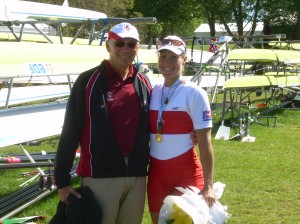
Lindsay with coach Mike Spracklen
Some people really criticize Mike for his aggressive attitude toward training when fatigued and in adverse conditions.
He’ll take us out in wind that’s stronger than what a sail boat would be happy to sail in, and it’s cold and raining and probably somewhat dangerous. There are days like that when you know you must not be rowing the best you can. I’ve heard some women say that in times like these, they could ‘get a better workout on the erg.’ I struggled with believing in that (the benefits of rowing in adverse conditions). I believed that there was some other, more valuable reason why we were braving the elements.
Mike said something after the world’s last year to the men that I wrote down because it epitomized what I was trying to understand about not missing workouts due to being tired or it’s being windy.
He said, “it’s not missing a session that loses the gold. It’s the psychology behind it. Don’t be happy to miss training. “
I thought, aha! That’s what I’ve been trying to define.
It probably isn’t negative on your physiology to take it in early because your back has a niggle, or the water isn’t perfect. But you’re weakening the mind. Those rows he leads us through are rows for our psychology; not our bodies.
If we can get through those, we can get through the Germans, the Brits, the Americans, etc. Or at least, that’s what we believe we can do, and that’s half the battle – maybe more. Our final (at the 2010 world championships) was rowed in the worst, raging head wind I have ever raced in.
Enough said.
Do you feel you train any differently with the men vs. the women?
Definitely.
The obvious thing is that the training program is entirely different. We do more steady state rows, that aren’t killing yourself, with the women. That’s positive because it gives you a chance to focus on what it is that you’re doing. I think it’s beneficial to row less fatigued and row really well, and to row really well when you are really fatigued because that’s when you make the biggest gains.
Another major difference is that with the women I have to be on my best behavior. With the men, anything’s fair game, and it all gets left on the water. It’s liberating really. But it’s also good to be made to act like a lady once in a while. Thanks girls!
Do you or did you feel the men treat you differently than they treat each other?
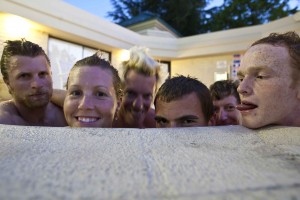
A little down-time with the heavyweights including Gabe Bergen, Lindsay, Steven Van Knotsenberg, Doug Csima and Will Crothers (Photo Kevin Light)
I think yes and no.
I end up in the back of the boat bay and there are pants being dropped like it’s any other male team mate back there. I laugh it off and tease them, but I take it as a compliment really. They all feel pretty comfortable around me and that really makes me feel part of the team.
The ways they treat me different are few. The most flattering and encouraging is that I really feel that most of them are 100% in my corner. They cheer me on in pieces when they finish first, and I always get a sense that they truly want to see me succeed and do well. That’s a great feeling and it’s not something you can really expect from the women because at the end of the day, until we’re in a boat together, we are each other’s competitors. The men are and always will be my team mates first.
One last question: any stories you’d like to share about training with the men? Particularly leading up to the last Olympics or next?
I have a general observation to share.
I am probably the only non-heavyweight, non-male rower that has seen first-hand what these guys do every day. They have wives, girlfriends, family and other teammates that get glimpses of their days. Some hear about it and understand really well; others not so much. I feel like I know what went into that silver and gold medal from Beijing.
I can say without a glimmer of apprehension that those men worked harder than anyone I know for what they accomplished. The work ethic, the focus, and the dedication on the men’s team is unmatched. I know their 2010 results did not reflect what I am describing, but you’re going to see them leading some races this year and next. I know it!
My time (training) with these guys is scarily drawing to an end, but they have all taught me so much about being tough and relentless. No matter where my training takes me over the next 15 months, they will be with me.
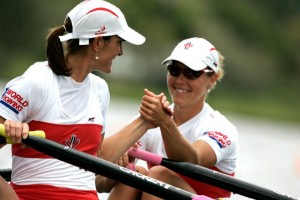
2010 LW2X world champions Lindsay Jennerich and Tracy Cameron (Photo Kevin Light)
Thanks for sharing, Lindsay.
Follow Lindsay Jennerich on her blog, Join the Journey at www.lindsayjenner.blogspot.com.
Training Hard? Breathe Easy.
August 1, 2011
Yoga-based techniques to help improve your athletic performance
By Yasemin Watkins for Coach Kaehler
What’s one way you can improve your athletic performance using Pranayama –yoga-based breathing techniques?
According to Ed Harold, co-owner of Comfort Zone Yoga Center for Whole Self Healing, focus on your diaphragm – the dome-like muscle which separates your thoracic cavity from your abdomen and assists in your breathing.
“Learn to ‘thicken’ your diaphragm muscle,” says Harold. “The stronger the muscle, the greater your ability to lift and expand your chest cage.”
Harold, otherwise known as the “athletic yogi,” has been a lifetime competitor in everything from football to water sports, but confesses that his “greatest love of all is rowing.”
After sustaining a series of low-back and knee-related injuries, Harold turned to yoga for relief, recovery and eventually an entirely new approach to athletic training.
Through his studies to become a certified yoga instructor, Harold learned various yoga-based breathing techniques, Pranayama, and started integrating them into his athletic programs.
Here are some of Harold’s suggestions for integrating yogic-based breathing techniques into your own training programs:
Breathe through your nose at least 50% of your workout
Nasal breathing supports good posture in low back.
“Warming up using nasal breathing also activates the parasympathetic branch of the autonomic nervous system which sets your body into a fat burning zone rather using vital sugar reserves,” says Harold.
Mouth breathing, on the other hand, “doesn’t move the diaphragm as well and only activates the sympathetic branch hormones which athletes should reserve for racing and intense pieces.”
Harold recommends breathing through your nose, moving your diaphragm up and down at least 50% of your workout.
“Your first awareness of breathing using this approach is an ‘ocean’ sound in
your trachea, not your nasal channels,” offers Harold. “To do this, slightly constrict the upper trachea (epiglottis muscles in your throat). This will help control the length, depth, pace of inspiration and expiration.”
Use a ‘four-part breath’
Working with a four part breath: inhale, hold breath in, exhale, and hold your breath out.
“This technique warms-up your body quickly without wearing out joint tissues and destroying muscle mass,” says Harold. “Use mental or stroke counting to hold the left cortex present and in moment. Hold your breath in to increase the energizing effects of oxygen deeper into the nervous system. Then hold your breath out to remove stale air out of alveoli sac’s in your lungs.”
Observe the length of your inhales and exhales
Learn to manage your heart rates by noticing the length of your exhales and inhales.
“When your exhale shortens to less than your inhale, you are stressing your body and beginning to leave your ‘comfort zone,” says Harold.
Relax facial muscles
Relax low jaw, cheek bones, relax muscles around the eyes and don’t move
crown of head
For more information on these and other yogic-based techniques and programs Harold teaches, visit www.comfortzoneyoga.com.
(We don’t believe that there is any one magic bullet to success – and that hard work, excellent training plans and great coaching lead to success and we try and add value and serving you in your quest for success. Our programs are intended to help you get to the next level and the information above can help you better understand the many facets that should be addressed. As stipulated by law, we cannot and do not make any guarantees about your ability to get results using our ideas, information, tools or strategies , or from third-party information we share with you. We don’t know you and, besides, your results in life are up to you. Agreed? We just want to help by giving great content, direction and strategies that move you forward, faster. Nothing on this page or any of our websites is a promise or guarantee of future training success. “These above techniques / approaches may not necessarily reflect the opinion of Coach Kaehler.” )
Shedding Light on Kevin Light
March 16, 2011
In Kevin’s words:
Shedding Light on Kevin Light
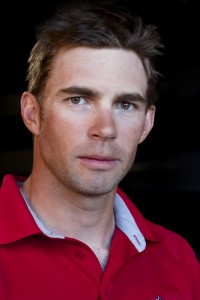
By Yasemin Watkins
Kevin Light is a three-time World Champion and a member of the 2008 Olympic Gold medal-winning Men’s 8+ crew from Canada. Light is currently training with Mike Spracklen in Victoria, BC for a chance to race in the 2012 Olympics in London, England (Light’s third Olympic games).
I spoke to Light recently and asked him to comment on three of his favorite photographs, as well as three of the greatest challenges of elite-level training: injuries, sacrifice, and finding balance.
In Kevin’s words. Here is what he had to say.
On photography
“(When I was young) I used to collect Olympic Coke Bottles. I thought one day, I want to compete in an event that’s on a Coke bottle.
I collect things that capture the emotion of a scene or moment. Photography captures the moment. I like the idea of capturing moments that will never come again, though it doesn’t have to be a photo.”
Lindsay Jennerich
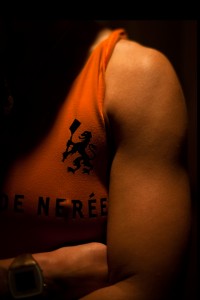
Photo: Kevin Light
Taking photos of Lindsay is fun.
I’m around guys all the time, and having her around offers a different subject. Lindsay has trained with Mike Spracklen’s group for quite a few years now, until she left for London, Ontario, where she partnered with Tracy Cameron and won the women’s lightweight double at the World Championships in New Zealand.
This photo was taken after an erg workout. Some of the lights were off and I asked her to stand under one of the overhead pot lights. (I’m getting better at asking people to pose when I see an interesting photo opportunity.) She laughed when I pointed the camera right at her chest, but the light on her arm and the orange suit contrasting with the dark shadows looked cool. When I was editing the photo later that night, I noticed her nipple was showing through her unisuit. At first, I thought it ruined the photo because it can be embarrassing or awkward for the subject, and I didn’t want her to feel this way.
The more I looked at the photo, however, the more I liked it. I think it has a strong athletic message. It shows an arm that is strong enough to be either a man’s or a woman’s. Since her face is not visible, her nipple is the only way to identify her as a female.
Throughout my rowing career, I’ve always cared more about my performance than my appearance. This photo reinforces that message because in a room full of 20 men, Lindsay pulls on her erg concentrating only on her performance, not about what she looks like. To me, this differentiates an athlete from somebody who works out at the gym for fitness.
When I look at this photo, I see Lindsay saying, “This is my body. This is who I am.” I think this message is inspiring, especially to young women with athletic aspirations.
I’m proud of my body because it is who I am.
Robert Weitemeyer
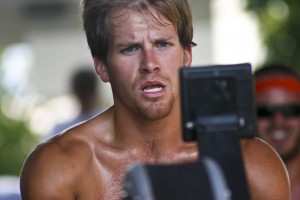
Photo: Kevin Light
At this point in my photography career (2005), I was not thinking about making photographs. I was just pointing the camera at people.
I have no idea what the settings — lens, aperture, shutter speed — on the camera were. The camera was on full automatic mode. This photo represents a time when I didn’t understand exactly what I was doing. Though I still have a lot to learn, I’m further along in that process now than I was six years ago.
During this period we didn’t have enough ergs, so there were two erg groups. One at 3pm and one at 4pm. Rob was in the 3pm group. The framing is good with the screen in the foreground and his eyes looking at it. Rowers can relate to how he is feeling.
Rowing is such a serene and almost spiritual sport. On the water, the oar can be manipulated, producing the feeling of gliding along flat water. That feeling is a stark contrast with the other way rowers train, which is probably the least spiritual of all the ways to exercise. You expend so much energy trying to get a number on a screen to drop by one. And at the end of all that effort, you get off in the exact same place that you started.
It’s like climbing a mountain knowing there is no view at the top.
Footsteps in the snow

Photo: Kevin Light
This is one of the most popular photos I have ever taken.
The footprints are interesting. But it wasn’t until later that I had realized that the photograph had an external message — similar to Lindsay’s photograph. It’s probably the most accurate description of what it’s like to row in an eight: it doesn’t matter who you are, you have to know your role, and be willing to fill it. If that happens, you and your teammates have the potential to create something very cool. The photo is a metaphor of how rowers work together to create something that lasts forever. It’s one of my favorites and hangs in my house with the signatures of all the men from our 2008 Olmypics team.
I’m always looking for my next big photo. This one makes me think of how a rock band must feel when they do concerts. Their fans only want to hear the hits, while the band wants to play their newer, less popular music. They are proud of their old songs as I am with this photo, but I’ve talked about it and seen it so many times that it’s lost some of its excitement for me. That said, I’m really glad I had my camera that day to take this photo.
Injuries
I used to think that injuries were a part of sport. If you weren’t getting injured, then you probably weren’t pushing yourself to the maximum of your potential.
Now that I’m older and I little wiser, I still believe that, but there are a few amendments. If you’re irresponsible and don’t take actions to treat the small injuries and let them become bigger ones, then that’s your own fault. And that can happen with an easy training program. Also, blaming anyone else for your injuries won’t help.
When you do get injured, your role changes from rower to personal self-healer. I have been injured quite a bit. When I had vertigo in 2006, I learned that when you’re well, you should always do your very best. When you’re injured, you want to do anything to get back on the water. You get so bored of sitting around and visiting the doctors. You just want to row. Then other times, when you’re not injured, you don’t take full advantage of your healthy body. You shortchange yourself by not pushing to your full potential. Thoughts like, “I feel tired today I won’t go full pressure on the erg,” or “I only want to row 5km instead of 10km this afternoon.”
When you’re not injured, remember how much you wanted to row when you were injured.
Also, I believe that if you pull out of a workout because of an injury, you shouldn’t return to the workout the next day. If you rush back, you risk aggravating your injury. If you’re sick (which is kind of like an injury), I think it’s always better to wait an extra day before you come back. Your body gets used to a certain type of load. When you’re injured, you’re not stressing your body the same way and it adjusts to that lack of training volume. When you reintroduce your body to that volume, make sure that it is ready. If it’s not, you’ll be dealing with the side effects of increased fatigue and the repercussions of a nagging injury at the same time.
Also, if you’re injured, limit the times your teammates see you leave early from a workout. It’s better to go into the dock early once and not be seen for 10 days, than it is to be seen going into the dock early 10 consecutive times after trying to row with an injury.
Sacrifice.
It really depends how you think about sacrifice. I know more training will give me a better chance to win. And winning is what I want to do.
Over the past 10 years, I have sacrificed many things an average person would not. But I’m not interested in being an average person. When I say “sacrificing” I mean missing out on normal things — things I would like to do that require no specific skill but are enjoyable. Things like watching an NHL hockey or a football game, or going out on a Friday or Saturday night. I don’t believe that I have sacrificed that much for all the rewards I’ve been given.
I love exercise and I get to exercise everyday day and get paid for it. Not very much, but I still get paid. I will be starting my career as a photographer at 33, when normally I would have started a lot earlier. But at the same time, I will be changing careers at 33 having absolutely loved how I spent the last 15 years of my life. I probably would have had a job and kids by now had I not been rowing, and I guess that is a bit of a sacrifice. But I can still do those things.
I believe that there are more people who are envious of my life and the things that I have accomplished, than I am of theirs. But then again not everyone likes sports, so that statement may be a little bit presumptuous. Some days, I still can’t believe that I won a gold medal at the Olympics. Learning what it takes to win has provided me with so many skills and opportunities that I can hardly say that the last 14 years of my life have been a sacrifice. It would only be a sacrifice if I didn’t give 100% effort each day.
If I spent the last 15 years rowing and never won anything, then I would say it would have been a huge sacrifice and a waste of time. I’m so scared of being average, and I’m not average in some of the things I do and collect. But I’m proud of who I am and the things I have done.
Finding Balance.
People say how important it is to have balance.
They tell me how lucky I am to have photography and videography as something that can distract me from rowing. The only thing is that 90% of my photos and pretty much all my video work is about rowing. So it’s not as much a distraction as you may think. I can see how having something else to occupy your time can be useful. The only problem is that I’m usually so tired, that I don’t have the extra brain power to get much accomplished.
What I have discovered over the last few months is that the less I do (because I’m tired), the more tired I feel. So lately I’ve been trying to set at least one goal. Clean my room, empty the dishwater or whatever. Just something small that does not require much effort, but makes me feel like I’ve actually accomplished something. I feel less like a bum, and therefore less tired. The more tired you think you are, the more tired you will become.
I need my rest between workouts. But feeling bad about myself for not accomplishing anything can also lead to low self-confidence in other areas of my life, especially on the water. Finding balance in that way is also important. I never feel worse than sitting in front of the TV watching reruns of ‘Two and a Half Men’. That makes me feel fat and stupid. I started watching more TV shows where I actually learn something.
Surprisingly, getting up after watching informative TV, I feel more educated and that helps me recover and stay fresh for the next day of rowing.
To See More of Kevin Light Photo’s Click Here
New!! Coach Kaehler’s Strength and Power Development for Rowing – Camps
March 10, 2011
- You want to improve your strength and power
- You want to avoid injuries
- You want a program tailored to your strength and flexibility
- You want Coach Kaehler’s Body-Balanced approach to getting stronger and more powerful!
At last, a complete, all-in-one approach to developing a sound and proven-effective strength and conditioning program to fit your personal needs, based on your individual Body Balance evaluation conducted by Coach Kaehler.
Coach Kaehler combines years of experience as an elite athlete, a musculo-skeletal specialist (PT and CSCS), and physiological professional, to share with you the same principles and techniques he teaches to top-level programs and athletes.
Ideal for athletes of all levels (high school, college, masters and elite).
Temple Men’s Rowing Team Starts using Body Balance Strength System
January 24, 2011
Today I was privileged to be able to teach my Body Balanced Strength Training System to the Temple Men’s Crew Team. We had an early start at 5:45am and got them through the first workout successfully. One down 23 to go! GO OWLS!!
January 28-29th, 2011 – Coach Kaehler will be offering his Balance Evaluations to the San Fransisco Rowing Community
January 2, 2011
Join 3-time Olympian, 4-time World Champion Coach Kaehler
For One-on-One Body Balance Evaluation Sessions
Where: California Rowing Club and BIAC
When: Friday, January 28th (Marin Rowing Club) and Saturday, January 29th, 2011 (BIAC)
SUFFERING from chronic training related injuries? This process will help you to correct your imbalances and return you to pain-free rowing!!
Ideal for Master’s, collegiate and high school athletes who want to take their rowing to the next level.
Coach Kaehler teams with California Rowing Club to offer an intensive Body Balance weekend featuring one-on-one sessions which helps to improve your rowing strength and power, and eliminates chronic training related pain.
See why coaches from leading high schools and colleges, including Northeastern and Harvard, and St. Joe’s Women to name a few, have made Coach Kaehler’s clinics and evaluation process a must for their training programs.
Space is limited so Sign-up NOW!!!
Body Balance Structural Evaluations (90 minute individual sessions) $379
Understanding and correcting your specific flexibility and strength imbalances is essential to helping you achieve a long, powerful, and balanced rowing stroke. These one-on-one sessions include Coach Kaehler’s comprehensive Body Balance Structural Evaluation, followed by a personalized program of easy-to-follow exercises that address and correct each of your structural issues.
Body Balance helps athletes row more powerfully and avoid injury by shifting stresses of the rowing stroke toward proper support muscles, and away from your low back and other joints.
Use this simple, but highly effective system to improve your performance and enjoy rowing to your potential!
2010 Jim Joy Conference – Saratoga Springs, NY – Body Balance Evaluations – December 11th
November 30, 2010
Join 3-time Olympian, 4-time World Champion Coach Kaehler
for Body Balance Evaluations
Where: Saratoga Rowing Association Boathouse
When: December 11, 2010
Ideal for high school,college, and master’s rowers and coaches, who want to take their rowing to the next level.
Reserve now at Camps and Clinics (sign-up info)
Body Balance Structural Evaluations (90 minute individual sessions)
Understanding and correcting your specific flexibility and strength imbalances is essential to helping you achieve a long, powerful, and balanced rowing stroke. These one-on-one sessions include Coach Kaehler’s comprehensive Body Balance Structural Evaluation, followed by a personalized program of easy-to-follow exercises that address and correct each of your structural issues.
Body Balance helps athletes row more powerfully and avoid injury by shifting stresses of the rowing stroke toward proper support muscles, and away from your low back and other joints.
Use this simple, but highly effective system to improve your performance and enjoy rowing to your potential!
Where: Saratoga Rowing Association Boathouse, Saratoga Springs, NY
Time Slots: Saturday, December 11, 2010
07:30 – 09:00 am – available
09:00 – 10:30 am – available
10:30 – 11:30 am – Bo0ked
11:00 – 12:00 pm – Booked
1:00pm – 2:30pm – Booked
2:30 – 4:00 pm – Booked
Additional times are available, please contact if interested.
After making your purchase, please contact Coach Kaehler to reserve your preferred time.
Contact Page – Coach Kaehler
November 15, 2010
Hello All,
It has come to our attention that the “Contact Page” on the Coach Kaehler web site has not been operating properly over the past several weeks, we apologize. While we have been updating the web site in order to offer you better service we have noticed that messages put through the “contact page” have not reached us. We have fixed the problem and apologize for not getting back to those who sent messages. Please feel free to Coach Kaehler directly with any questions or comments at: coach at coachkaehler.com (at=@)
The updates will include a brand new “Product Page” with all new products.
Best,
Team Coach Kaehler
November 6th, 2010 – Body Balance Evaluations – Greenwich, CT
October 15, 2010
Join 3-time Olympian, 4-time World Champion Coach Kaehler
for Body Balance Evaluations
Where: Greenwich Water Club
When: November 6, 2010
Ideal for high school,college, and master’s rowers and coaches, who want to take their rowing to the next level.
Reserve now at Camps and Clinics (sign-up info)
Body Balance Structural Evaluations (90 minute individual sessions)
Understanding and correcting your specific flexibility and strength imbalances is essential to helping you achieve a long, powerful, and balanced rowing stroke. These one-on-one sessions include Coach Kaehler’s comprehensive Body Balance Structural Evaluation, followed by a personalized program of easy-to-follow exercises that address and correct each of your structural issues.
Body Balance helps athletes row more powerfully and avoid injury by shifting stresses of the rowing stroke toward proper support muscles, and away from your low back and other joints.
Use this simple, but highly effective system to improve your performance and enjoy rowing to your potential!
Where: Greenwich Water Club, Greenwich, CT
Time Slots: Saturday, November 06, 2010
9:30 – 11:00 am – available
11:00 – 12:30 am – available
1:00pm – 2:30pm – available
2:30 – 4:00 pm – Booked
4:00 – 5:30pm – Booked
Additional times are available, please contact if interested.
After making your purchase, please contact Coach Kaehler to reserve your preferred time.
